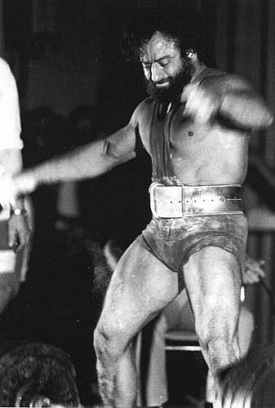You know what? You guys don’t know shit. You don’t know what a hard day’s work is. You don’t know what it’s like to bleed and sweat. You don’t know how to dig DEEP, real DEEP, and get that last big of your SOUL and have it consume your nether region. You don’t know how to get a TASTE of the HARD work that is associated with being a champion. You don’t understand that to BE THE MAN, you have to BEAT THE MAN. This video teaches you a thing or two about training with a champion’s intensity. Take notes, you pile of shit.
MD Grand Prix
Muscle Driver is hosting a series dubbed as The Muscle Driver Grand Prix Series. In a time where people complain about USAW and how the sport of Olympic weightlifting needs to grow, MD is making an effort to generalize Olympic weightlifting, make it accessible, and most importantly, make it fun.
Specifically this means MD is hosting meets around the country and awarding cash prizes for the top Sinclair formula finishers. The inaugural meet is on November 5th in Charllotte, NC.

So many people have given their two cents on how to build the sport of weightlifting, and this is the first major non-USAW event to do so. Next year MD wants to give away at least $50,000 in prize money! There are even negotiations to get the final event televised on ESPN. This would be a huge boost for the sport as it hasn’t a) been popularized in culture and b) hasn’t ever compensated athletes monetarily.
The whole series is extremely accessible, but especially this first meet; anyone at any age can enter. More so, many top tier American lifters won’t be competing at this event because they are prepping for the American Open or the Olympic trials early next year. This means that anyone can walk away with prize money, ranging from $400 to $2,000. This opens the door for new or inexperienced lifters to end up on the podium and awarded some cash. I can’t say this definitively, but there aren’t many Americans (if any) that can say they won some dough by doing well at a weightlifting meet.
I’ve seen some resonating skepticism on the internet about the meet being “too big for my first meet” or “too big of an event, I’m not good enough yet”. This is the same weak behavior that everyone shows when faced with the “daunting task” of actually competing. Look: my first meet was in a barn in Texas and was basically a structured practice session. I had a great time, but it would have been a lot of fun to go to a very nice venue with top of the line equipment in the warm-up room. Not to mention some of the top coaches in the US will be there to specifically help beginners. This is the perfect opportunity to receive help from experienced coaches. When I went to Nationals in 2010, Paul Doherty lent a helping hand despite the fact that I was competing with one of his lifters (Ben Claridad). There will be more of the same at this MD meet.
Lastly, I have it on good authority that Glenn Pendlay will be racing Brad Hess in a C2 rowing competition. I’m almost positive he’ll puke.
Bottom Line:
If you’re on the fence about doing your first meet, commit to this MD Inaugural meet and you’ll have a great time. It’s a nice venue with nice equipment and nice people. You’ll walk away a better lifter for sure.
Getting Girls To Train – 6
Egad! Internal Rotation!
It’s pretty common to see girls internally rotate on the press and bench press (guys do this too, and I say this because I’m ALL about equal opportunity and shit…) regardless if they are new to lifting or are experienced (I’m irritated I even have to clarify this). It could be due to a lack of a proper motor pathway, the coach’s fault for not addressing it, or a lack of musculature, specifically in the triceps. In any case this issue should be addressed soon. Some resources to elaborate on this topic include a video on internal rotation and improving the push-up and an article on how the internal rotators contribute to the bench press.
There are two ways to address this internal rotation problem: cuing it properly while doing the exercises and develop the musculature over time so that it can be done correctly. If we are going to cue the lifts, we have to assume that proper mechanics and set up exist; the most important is a correct grip where the forearms are vertical at the bottom ROM of the lift (start of press, bottom of bench).
Pressing
It’s been my experience that girls are fully aware of the location of their breasts even when not knowing what their body is doing during lifting. A simple “elbows to boobs” cue can help align their elbows and subsequently humerus (upper arm bone) into a properly externally rotated position. This cue works the best, but “elbows to ribs” could also be used — perhaps for the less endowed girls (I kid; they still know where their boobs are, they are just harder to find). Muscular guys can sometimes use “triceps to lats” for the same effect. If the concept has been taught and fully understood, “elbows in” could be used and is particularly helpful if the lifter is internally rotating in the middle of the lift (flaring the elbows on the way up).

If the lifter internally rotates in the middle of the lift, then they are either not performing the cue properly (in which case good coaching needs to occur) or they are using too much weight to do it properly. It’s likely that properly external rotated positions will not allow the same weights to be pressed because the lifter has adapted to the wrong way. If you’re lifting by yourself and know that you are internally rotating (either by feeling it or from video), then drop the weight and do it correctly over time. It’s not like you are trying to impress anyone since you’re forever alone anyway.
Bench Press
Internally rotating on the bench press is more notable since the elbows can flare to perpendicular relative to the torso. There are many ways to correct this, including aiming for a 45 degree angle with the elbows, “elbows to ribs”, “elbows to lats”, “spread the bar apart”, or “elbows in”. The primary issue with improving internal rotation in either lift is that it has to occur consistently over time so that the structures develop in a way that executes the new externally rotated position properly.
Developing the Structures
Most guys, especially those that have been lifting for at least a year, can make the adjustment and improve their positioning by cuing it correctly, lowering the weight, and doing it consistently. Someone in this scenario may need to improve the frequency or volume of that lift in their program to garner enough reps to make a muscular change. Girls, on the other hand, will benefit from ancillary exercises. I’ve used the seated assisted dip machine to help develop the triceps of a girl to augment proper press and bench positioning. These work really well because during a dip the elbows (are supposed to) stay close to the ribs and develop the middle of the triceps — the part that primarily helps the press and bench. I’ve also put an emphasis on exercises like pull-ups, chin-ups, barbell rows, and dumbbell rows to develop the upper back to help positioning and to strengthen the area around the shoulder girdle. Keep in mind that isolation exercises will hardly be relevant for developing musculature to augment the primary lifts and instead you should use compound exercises (i.e. dips instead of triceps extensions).
Start paying attention to your internal rotation whether you’re a dude or a chick. If you’re doing it wrong, try out one of these cues and focus on it for a few weeks. It may require a reduction in weight, but it will pay dividends for your strength, joint health, and musculature in the long run.
Q&A – 1
theturgid asks
Justin, how do you deal with persistent stalling/failing on TM? (All lifts, but mostly squat) The ebook mentions manipulating VD but that isn’t working for me. The options I see are:
1) Reset ID back 10% like in SS
2) Take a deload or week off?
3) Just deal with the slowed progress and accept a failure every 2nd or 3rd week?
4) Something I haven’t thought of?
After I asked what his Volume Day and Intensity Day numbers were:
my squat VD is 264# and ID is at 341 – I only got 3 reps last week, was going for 5, hopefully will get the 5 this friday
Dear theturgid,
Typically I see numbers higher than yours in a TM set up, but it doesn’t mean it’s impossible. You are 6’2″ and weigh about 210 lbs (he said this in another comment), which isn’t that large for the height. You also said you don’t think your diet is the issue or what your goals are, but I have to assume you aren’t eating enough properly. Are you eating a MINIMUM of 250g of high quality protein? I like the 77 pound discrepancy between the VD and ID (although your VD rep scheme wasn’t specified), but you may require an increase in volume, especially since 264 is not a significant amount of stress for a 210 lb guy.
Under the assumption that you are doing everything in training, life, and recovery correctly (which is highly unlikely for most readers of this site), there are some more advanced techniques that will be out very soon in Part II of the Texas Method E-book. Sorry for the cliff hanger, but reevaluate the ancillary stuff and increase your volume slightly and see what happens.
Continue reading
PROTEIN
I can’t say this any better than Mauro G. Di Pasquale, who is becoming a hero of mine.
However, for those athletes involved in strength events such as the Olympic field and sprint events, those in football or hockey, or weightlifters, powerlifters, and bodybuilders, I recommend between 1.2 and 1.6 g of high-quality protein per pound of total body weight. That means that if you weigh 200 lb and want to put on a maximum amount of muscle mass, then you will have to take in as much as 320g of protein daily. There are several competitive weightlifters, powerlifters, and bodybuilders that I know who take in 2-3 g of high-quality protein per pound of body weight.
If you are trying to lose weight or body fat it is important to keep your dietary protein levels high. That is because the body oxidizes more protein on a calorie-deficient diet than it would in a diet that has adequate calories. The larger the body muscle mass, the more transamination of amino acids occurs to fulfill energy needs. Thus for those wishing to lose weight but maintain or even increase lean body mass in specific skeletal muscles, I recommend at least 1.5g of high-quality protein per pound of body weight. The reduction in claories needed to lose weight should be at the expense of the fats and carbohydrates, not protein (345).


